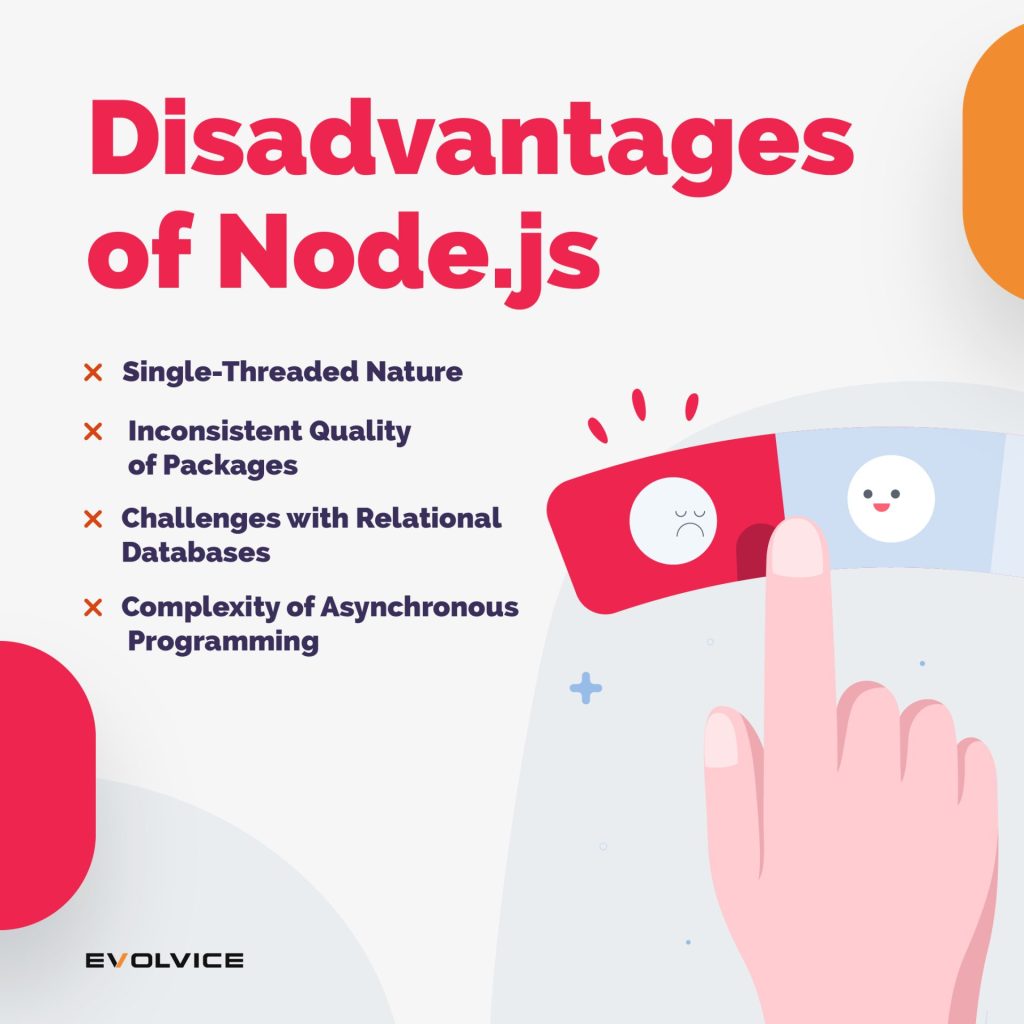In the dynamic world of web development, selecting the perfect technology often ignites spirited debates, particularly in the realm of Nearshore software development, Outsourcing software development, and Managed Services. Nevertheless, one solution that has consistently risen above the rest is Node.js. This potent, JavaScript-based runtime environment has sculpted the contemporary web landscape, empowering Nearshore software developers and Managed Services teams to construct speedy, scalable, and effective web applications. But how do you identify the best situations and reasons for deploying this trailblazing technology, especially when considering Nearshore software solutions?
In this comprehensive guide, we’ll explore why Node.js has become the go-to solution for developers worldwide. Dive into this exploration with us as we demystify when to use Node.js and address burning questions like “What is Node.js good for?” and “When to use Node.js?” within various development scenarios.
Node.js Essentials: A Brief Overview
Node.js, an open-source, cross-platform JavaScript runtime environment crafted from Chrome’s V8 engine, demolishes age-old limitations that once confined JavaScript within the browser’s constraints. Its trailblazing capabilities pave the way for high-performance, scalable web applications. While grasping Node.js’s benefits and use cases is crucial, such discernment necessitates a previous dissection of its architectural and operational mechanics.
Node.js Architecture: The Inner Workings
The Node.js architecture is built on two key principles: non-blocking I/O operations and an asynchronous paradigm.
The first principle, non-blocking I/O operations, highlights how Node.js employs these operations to ensure the smooth processing of client requests. This method allows for the simultaneous execution of I/O operations without obstructing the primary thread. The advantage of this approach is twofold: it significantly enhances efficiency while guaranteeing a higher degree of responsiveness.
The second principle, the asynchronous paradigm, showcases Node.js’s commitment to an asynchronous programming model. This aligns seamlessly with JavaScript’s event-driven essence. With intelligent use of callbacks and event-driven programming, Node.js optimizes resource utilization and circumvents the potential bottlenecks inherent in synchronous operations.
These two principles, combined with JavaScript’s event-based model, emphasize the importance of understanding the fundamental components of Node.js application architecture.
Core Elements of Node.js Architecture
At its heart, Node.js architecture consists of six critical elements:
Requests: Incoming requests in a web application can be classified as either blocking (complex) or non-blocking (simple), depending on the specific tasks users intend to perform.
- Node.js Server: It serves as the base of the architecture, operating as a server-side platform. Node.js Server not only accepts requests from users but also diligently processes them, delivering corresponding responses.
- Event Queue: The Event Queue within the Node.js server functions as a storage mechanism for incoming client requests. It passes these requests, one at a time, into the Event Loop for further processing.
- Event Loop: It represents a perpetual loop that continuously receives requests from the event queue, processes them, and returns the appropriate responses to clients. This loop encompasses six distinct phases: timers, I/O callbacks, waiting/preparation, I/O polling, set Immediate() callbacks, and close events. These phases repeat until all code execution is completed.
- Thread Pool: The Thread Pool, a vital component of Node.js backend architecture, houses threads responsible for executing tasks necessary to process client requests efficiently.
- External Resources: External Resources play a significant role in handling and blocking client requests. They are specifically designed to manage multiple blocking requests, such as data storage and computation, without impeding the overall system performance.
Grasping the functionality and flow of these components is paramount in Node.js application development. The modular architecture of Node.js, composed of these crucial elements, drives the success of applications built upon it.
Additional Components of Node.js Architecture
Moreover, Node.js encompasses other components that further enrich its architecture:
- Event Emitters: Node.js‘ EventEmitter class is instrumental in creating and managing custom events, thereby strengthening the development of responsive, event-driven applications. It offers developers the flexibility to define their own events that are triggered under specific conditions, leading to personalized and efficient applications.
- Asynchronous APIs: Node.js brings to the table a collection of asynchronous APIs that cater to various operations, such as file system access, network communications, and database queries. These APIs advocate for non-blocking code, which in turn facilitates efficient handling of concurrent requests, keeping the application performance optimized, even under heavy load.
- Modules: Node.js leverages a module system for effectively organizing and reusing code. Modules encapsulate related functionality, facilitating the development of modular applications. Node.js provides a comprehensive set of core modules, including HTTP, File System, and Crypto. Additionally, developers can create and utilize custom modules, promoting code modularity and maintainability.
Node.js also includes NPM (Node Package Manager), a robust package manager bundled with the platform. NPM grants developers access to a vast ecosystem of open-source libraries and modules, allowing them to install and manage external dependencies with ease. It fosters productivity and collaboration within the Node.js community.
There are more than two million packages in the npm registry
Also worth mentioning is Libuv – a core component of Node.js that supports asynchronous I/O operations. It’s a multi-platform C library that forms the essence of Node.js, handling multiple concurrent connections efficiently. With its event loop and non-blocking I/O model, Libuv ensures that Nodejs remains lightweight and scalable.
Top Benefits of Node.js
Node.js has swiftly emerged as a foundational pillar in contemporary web development. Its meteoric rise can be predominantly attributed to the extensive range of advantages it bestows upon its users. In the following discourse, we will explore the paramount advantages of Node.js and make a compelling case for why this runtime environment is commendable and an exceptional choice for many applications.
1. Scalability and Performance
Node.js was meticulously engineered with a steadfast focus on scalability and performance. Its groundbreaking event-driven and non-blocking paradigm seamlessly orchestrates the swift and proficient handling of a multitude of simultaneous requests. In addition, the formidable Google V8 engine, which drives Node.js, diligently compiles JavaScript into machine code, propelling lightning-fast execution.
2. Versatility and the Use of JavaScript
Node.js’s key strength is its support for server-side JavaScript, unifying client-side and server-side development, streamlining the process, and expediting development cycles. The widespread use of JavaScript further enhances Node.js’s appeal due to abundant resources, tutorials, and community support.
3. Code Reusability and Sharing
Node.js encourages code reuse and sharing. Thanks to npm, developers can package their solutions into modules and share them with the community or import packages created by others to avoid „reinventing the wheel.“ This principle of code reusability can drastically shorten development cycles and promote maintainable and clean code.
4. Rich Ecosystem
Node.js boasts the world’s largest ecosystem of open-source libraries, providing many ready-made solutions and packages that can significantly expedite the development process. This vibrant ecosystem fosters continuous innovation and collaboration, adding an element of communal support that developers worldwide cherish.
5. Microservices Architecture
Finally, Node.js reigns supreme as the ultimate choice for building applications within a microservices architecture. Its lightweight nature and modular design make it easy to break down complex applications into simple, decoupled, and manageable microservices. This can significantly improve application flexibility, resilience, and scalability.
In summation, When developing large, complex Node.js backends, using an established framework can improve structure, scalability and long-term maintenance. Some popular options like NestJS and Express provide out-of-the-box utilities that handle common tasks.
Features like routing, middleware, dependency injection and modular design allow focusing on application logic rather than recreating foundations. Well-designed frameworks also consider critical production concerns like performance, error handling and security.
Additionally, frameworks are often very mature, having been battle-tested in major production deployments. They address scaling, dependency management, and testing to help applications grow smoothly under heavy loads.
Overall, leveraging a framework accelerates development while producing cleaner, more robust code poised for growth. For building large Node apps, frameworks save significant time and reduce long-term maintenance burdens – all while standing on the shoulders of an extensive community.

Disadvantages of Node.js
While Node.js has reshaped the web development landscape with its wide array of advantages, it’s equally important to acknowledge its limitations. Discussed below are some of the significant challenges that come with the use of Node.js.
1. Single-Threaded Nature
Node.js operates on a single-threaded model, which is highly efficient for handling multiple concurrent connections. However, this architecture proves to be a bottleneck when dealing with CPU-intensive tasks. Since all operations share a single thread, any CPU-bound task can potentially block the entire thread, leading to performance degradation. Therefore, Node.js may not be the best choice for applications that involve heavy computations or processing.
2. Inconsistent Quality of Packages
The npm registry, while being an enormous repository of reusable code, does suffer from inconsistencies in the quality of packages. Not all packages are rigorously tested, well-maintained, or properly documented. This can lead to potential reliability and security issues, making it essential for developers to carefully vet packages before integrating them into their applications. It’s generally recommended to periodically scan for vulnerabilities in external dependencies and upgrade or migrate any that are found to be vulnerable.
3. Challenges with Relational Databases
Node.js interfaces superbly with NoSQL databases, like MongoDB, but struggles somewhat with SQL databases. The lack of mature libraries for handling SQL queries can introduce challenges for applications that rely on relational databases. As a result, developers may face inefficiencies in their code and potential performance bottlenecks.
4. Complexity of Asynchronous Programming
Asynchronous programming, which is a fundamental part of Node.js, can pose a steep learning curve for developers accustomed to synchronous programming. Debugging asynchronous code, managing callbacks, or handling Promises and async/await patterns can be complex and lead to messy code if not managed well. This could potentially slow down the development and compromise code quality.

What is Node.js used for?
Node.js has a broad array of applications due to its flexible and efficient nature. Here are some of the most common Node.js use cases you must know:
1. Real-time Web Applications
In light of its remarkable event-driven, non-blocking architecture, Node.js dominates the landscape of building real-time web applications, encompassing the likes of instant messaging and gaming applications. It efficiently handles multiple concurrent requests, making it perfect for situations where updates need to be instantly reflected across multiple users.
2. Chatbots and IoT Application
Node.js stands tall in scenarios thatrequire low latency and high data-intensive capabilities. These features make it a prime candidate for dealing with the torrential data rates of IoT devices while also providing smooth and swift conversational experiences in chatbots.
3. Collaborative Tools
Collaborative tools, like Trello or Google Docs, require real-time synchronization of data across users. Node.js, with its capability to handle numerous connections concurrently, is aptly suited for developing such applications.
4. Single-page Applications and Dynamic Websites
Node.js is used for building single-page applications and dynamic websites due to its ability to handle multiple requests asynchronously. It can serve dynamic content to users, improving the overall user experience.
5. Streaming Applications
An area where Node.js truly demonstrates its prowess is in the development of streaming applications. Its capacity to effectively manage data streams makes it an ideal choice for such projects. Node.js has the notable ability to process files during the upload process, a feat that effectively trims down the overall processing time.
6. Microservices and APIs
Node.js’s lightweight nature makes it a fitting choice for developing microservices architectures and RESTful APIs. It allows for applications to be split into smaller, manageable modules that can be developed, tested, and deployed independently.
In conclusion, Node.js is a powerful tool with a diverse range of applications, from real-time web applications to microservices. It provides developers with the features and capabilities needed to build scalable, efficient, and dynamic web applications, thereby reinforcing its place as a highly valued asset in modern web development.
Examples of Node.js Apps
The robust features and capabilities of Node.js have attracted a multitude of high-profile corporations and startups alike. Many popular applications we use daily are built using Node.js. While Netflix, LinkedIn, PayPal, and Uber are among the most famous, let’s examine some other impressive applications that owe their success to Node.js.
Walmart
Walmart, the largest retail corporation globally, adopted Node.js to serve its web and mobile platforms. The company decided to switch to Node.js for its server-side to efficiently handle the massive volume of customer traffic during Black Friday sales. The switch to a microservices architecture using Node.js enabled Walmart to provide a seamless, scalable shopping experience, even during peak traffic times.
Trello
Trello, a popular project management application, is another notable example of a Node.js application. Trello uses Node.js for its server-side, ensuring efficient handling of a large number of open connections for real-time updates, which is a critical feature in Trello’s functionality.
Medium
Medium, a renowned blogging platform, uses Node.js to serve millions of stories to its users every month. The use of Node.js has helped Medium scale its services efficiently, handling a vast amount of requests while maintaining a fast and responsive user experience.
eBay
eBay, one of the largest e-commerce platforms worldwide, opted for Node.js to maintain live connections with browsers and to increase the speed of their application. The event-driven, non-blocking nature of Node.js has provided eBay the ability to handle large volumes of user requests in real-time, thereby improving the user experience significantly.
NASA
Perhaps surprisingly, NASA turned to Node.js to keep astronauts safe during space missions. Node.js usage helps NASA to implement a microservices architecture, ensuring data related to any aspect of a mission is always available and accurate. The move to Node.js led to a reduction in data access times by a significant margin.
In summary, these Node.js uses illustrate technology’s versatility for many industry leaders, regardless of the sector. From e-commerce platforms to blogging sites, from project management tools to space expeditions, Node.js provides an efficient, scalable solution to various software development needs.

When Not to Use Node.js
As efficient and versatile as Node.js may be, it is not a silver bullet for all development scenarios. There are certain situations where the use of Node.js may not be the best choice. Let’s dig into the circumstances where the application of Node.js might not be optimal.
1. CPU-Intensive Applications
Node.js operates on a single-threaded, event-driven loop to handle multiple concurrent clients effectively. While this is excellent for I/O-intensive tasks, it’s not well-suited for CPU-intensive tasks. Applications that involve heavy computations, like image and video processing or machine learning algorithms, can block the event loop, leading to performance degradation. In these cases, languages like Java, Python, or C++ might be better suited.
2. Relational Databases
Node.js shines with NoSQL databases, but if your project heavily relies on a relational database, you might face some inefficiencies. Libraries for handling SQL queries in Node.js are not as advanced or intuitive as those for NoSQL databases. If your application’s core functionality is built around complex transactions and SQL queries, you might want to consider other technologies, like Ruby on Rails or Django.
3. Simple HTML and CRUD Applications
While Node.js is certainly capable of building simple CRUD (Create, Read, Update, Delete) and HTML applications, it might be overkill. If your application doesn’t require real-time data, scalability, or non-blocking features, a simpler framework like Flask for Python or Laravel for PHP might be a quicker and more efficient choice.
4. Lack of Experience
JavaScript, while popular, is also notorious for its quirks and can be tricky to master, especially when dealing with asynchronous programming and callback hell. If your team isn’t well-versed in JavaScript and the nuances of the Node.js application development process might be more challenging and time-consuming than it needs to be.
5. Large and Monolithic Applications
Node.js shines when it comes to microservices or service-oriented architectures. However, for large, monolithic applications, managing and scaling with Node.js can become challenging. In such scenarios, other robust technologies, such as Java or .NET, might be more suitable.
While JavaScript does support object-oriented programming (OOP), it does not provide the level of support seen in languages that are fully object-oriented, such as Java or C++. If your project heavily relies on strong object-oriented principles, it might be better to consider these alternatives.
Conclusion
While Node.js is a powerful tool for many applications, it’s essential to remember that no single tool can be the best choice for every job, especially when considering Nearshore software development, Outsourcing software development, Nearshore software developers, and Managed Services. Careful consideration of the project’s requirements and the technology’s strengths and weaknesses will ensure that you select the right tool for the job, whether that’s Node.js or an alternative technology.
Want to leverage the power of Node.js for your next project but unsure if it’s the right fit? Evolvice can help! Our expert consultants can guide you through technology selection, ensuring you choose the ideal solution for your specific needs, whether it involves Nearshore software solutions, Nearshore software developers, or Managed Services.
And if you’re looking for top Node.js developers to join your team, look no further! Evolvice has a global network of talented developers, including Nearshore software developers, and we can help you find the perfect match for your project.
Contact Evolvice today to discuss your project and explore how we can help you build a high-performing, scalable web application.


